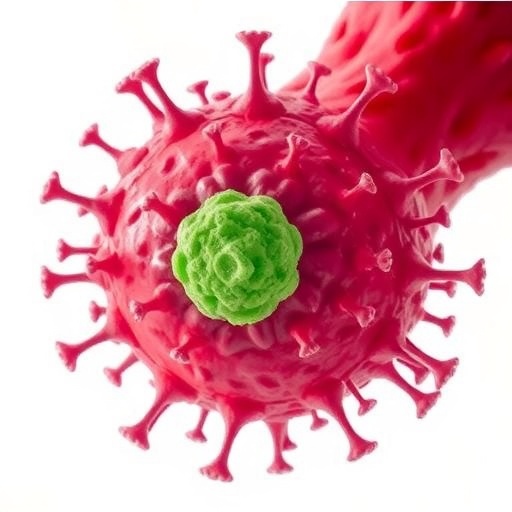In a groundbreaking study unveiling the stealth tactics of enteropathogenic bacteria, researchers have identified a sophisticated mechanism by which these pathogens evade the host’s cell extrusion defenses in the intestinal epithelium. The study reveals that the bacterial effector protein NleL orchestrates the targeted degradation of critical host proteins ROCK1 and ROCK2, thereby suppressing the extrusion of infected intestinal epithelial cells (IECs) and facilitating successful colonization.
The intestinal epithelium acts as a frontline barrier against microbial invasion, frequently responding to infected or damaged cells by expelling them in a process known as extrusion. This protective mechanism limits pathogen spread and preserves tissue integrity. Central to the extrusion process are the Rho-associated coiled-coil containing kinases ROCK1 and ROCK2, which mediate cytoskeletal rearrangements crucial for the ejection of dying or compromised cells.
Using human Caco-2 cell lines infected with enterohaemorrhagic Escherichia coli (EHEC) O157:H7 and a derivative strain lacking the NleL gene, the investigators demonstrated an NleL-dependent decrease in caspase-4 and ROCK2 protein levels during infection. Importantly, treatment with the proteasome inhibitor bortezomib rescued the abundance of these proteins, indicating that NleL directs their proteasomal degradation. This finding situates NleL as a potent bacterial ubiquitin ligase capable of dismantling host defenses at a post-translational level.
Further exploration into the biochemical consequences of NleL activity revealed altered signaling downstream of ROCK. Specifically, infection with the NleL-deficient strain resulted in heightened phosphorylation of myosin light chain 2 (MLC2), a direct ROCK substrate, suggesting that NleL counteracts infection-induced ROCK-MLC2 activation. This disruption of signaling cascades likely impairs the host cell’s ability to execute cytoskeletal remodeling and extrusion.
To test the functional significance of ROCK1 and ROCK2 in epithelial extrusion, primary mouse IEC monolayers were exposed to FlaTox, which activates the NAIP-NLRC4 inflammasome prompting pyroptotic cell death. The application of Y-27632, a selective ROCK1/2 inhibitor, significantly impeded extrusion of propidium iodide-positive (dying) cells. Similarly, genetic ablation of Rock1 and Rock2 markedly reduced the extrusion response. These results establish that ROCK kinases are indispensable mediators of epithelial cell extrusion elicited by inflammasome activation.
The researchers then investigated whether bacterial modulation of ROCK impacts extrusion during infection. Monolayers infected with Citrobacter rodentium lacking NleL exhibited significantly increased cell extrusion compared to those infected with wild-type bacteria, indicating that NleL restricts this host defense. Complementation of the mutant strain with NleL normalized extrusion levels, reinforcing the causal role of this effector. Microscopic analyses confirmed close association between adherent bacteria and extruding cells, strengthening the link between NleL activity, ROCK modulation, and extrusion inhibition.
Translating these findings in vivo, the study employed tamoxifen-inducible Rock1 and Rock2 knockout mice with IEC-specific deletion to dissect the contribution of ROCK kinases in host defense against bacterial infection. Notably, deficiencies of Rock1 and Rock2 did not compromise intestinal barrier integrity, as assessed by fluorescein isothiocyanate (FITC)-dextran permeability assays. However, Rock-deficient mice exhibited increased levels of colonizing C. rodentium compared to controls, highlighting that ROCK1/2 promote containment and clearance of bacterial pathogens.
Further infection assays comparing colonization by wild-type and ΔnleL C. rodentium reinforced the importance of NleL-mediated ROCK degradation in promoting bacterial persistence. While the NleL mutant strain displayed impaired colonization and dissemination in control mice, this defect was rescued in animals lacking ROCK1/2, underscoring the functional interplay between bacterial effectors and host kinases in infectious dynamics.
Biochemical analyses of colonic IECs from infected mice revealed diminished ROCK1/2 expression following wild-type but not ΔnleL bacterial infection, providing in vivo evidence for NleL’s role in degrading these kinases. Complementing this, live-cell imaging of IEC monolayers demonstrated accelerated extrusion rates in cells infected with NleL-deficient bacteria, confirming the phenotypic impact of NleL on the host cell extrusion process.
Interestingly, although NleL also targets caspase-4, a pyroptotic mediator, infected IECs did not exhibit increased cell death or interleukin-18 secretion in response to ΔnleL bacteria. This indicates that NleL’s role in modulating ROCK-dependent extrusion is somewhat independent of its effects on pyroptosis, likely due to redundancy in bacterial strategies such as expression of the caspase inhibitor NleF.
This research elucidates a novel bacterial immune evasion strategy wherein enteropathogenic bacteria utilize the effector NleL to subvert ROCK1/2-driven epithelial extrusion, thereby sustaining infection and enhancing colonization. By coupling biochemical degradation of host cytoskeletal regulators to functional suppression of cell extrusion, these pathogens gain a critical foothold in the intestinal niche.
The study’s insights into the intersection of bacterial virulence and host cytoskeletal signaling hold promise for targeted therapeutic interventions. Disrupting NleL activity or restoring ROCK kinase function might enhance epithelial barrier defenses, presenting innovative avenues to combat enteric infections. Moreover, this work emphasizes the multifaceted strategies employed by pathogens to manipulate host innate immunity beyond conventional antimicrobial resistance.
As the intestinal epithelium serves as a critical battleground between host and microbes, understanding the molecular crosstalk governing cell fate and extrusion has profound implications for infectious disease, inflammation, and gut homeostasis. This study elevates the significance of ROCK kinases as central hubs exploited by pathogens to undermine epithelial integrity.
Future research building on these findings may explore the broader repertoire of bacterial effectors targeting cytoskeletal pathways, their impact on host-pathogen interactions, and potential exploitation in treatment strategies. The delicate interplay between ubiquitin ligases like NleL and host signaling nodes offers a remarkable glimpse into microbial subversion of host biology.
In sum, the discovery of NleL’s targeting of ROCK1 and ROCK2 to inhibit epithelial cell extrusion constitutes a major advance in our understanding of bacterial pathogenesis. This mechanistic insight spotlights the evolutionary arms race at the intestinal barrier and refines our grasp of the molecular underpinnings that dictate infection outcomes.
Subject of Research: Host-pathogen interactions, specifically how enteropathogenic bacteria modulate epithelial cell extrusion in the intestine.
Article Title: Enteropathogenic bacteria evade ROCK-driven epithelial cell extrusion.
Article References:
Luchetti, G., Miner, M.V., Peterson, R.M. et al. Enteropathogenic bacteria evade ROCK-driven epithelial cell extrusion. Nature (2025). https://doi.org/10.1038/s41586-025-09645-0
Image Credits: AI Generated




